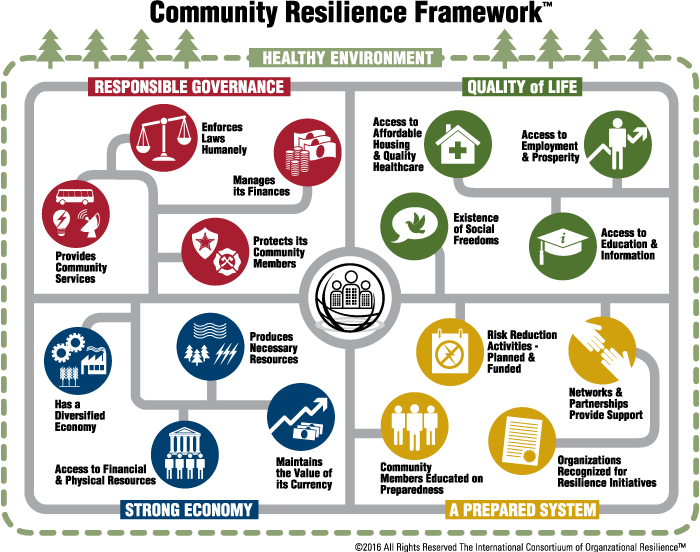Reading Time: 4 minutesOn Wednesday I attended an interesting Emergency Planning Society event loosely themed around community resilience.

It’s a term which means different things to different people and more often than not the starting place for discussion is about definitions. “What does Community Resilience mean?”
Boring.
We should instead, embrace that it’s a broad term, with varied interpretations depending on individual perspective and one which will change over time. Rather than getting hung up on what it is, we should focus on what we can do.
One of the things we can do is to be braver and more innovative. At the event Helen spoke about Naturvation, a European project looking at green infrastructure solutions to city challenges, the highlight was the unintended consequence of a Melbourne project which allows people to email love notes to 70,000 trees!
Three comments from speakers and attendees on Wednesday gave me the shivers. So I’m going to use this post to take each of those points in turn and explain my perspective, and then give a suggestion on approaching community resilience (or maybe just resilience) differently.
‘We are living in a riskier society’ – Lord Toby Harris
Lord Harris is the President of the Institute for Strategic Risk Management. He knows his stuff and is a fantastic advocate for the resilience profession. But I’m not convinced that the evidence is truly there that our world is getting more unsafe. More unsafe compared to what?
On one hand, I agree with Lord Harris that complexity is increasing and that the speed of global communication brings some new aspects. However, we should consider this against changes in demography and our collective risk tolerance.
World War One resulted in approximately 40 million casualties. The Black Death is estimated to have killed up to 60% of 14th century Europe. Baby Boomers and Millennials have experienced less real risk than nearly all generations that preceded them. Our risk perception, the things we choose to be concerned about, reflect our values as much as any objective knowledge of the hazard.
The world is definitely not without significant problems, but it’s important not to lose perspective and to understand where our rhetoric comes from and what underpins it.
‘We’ll all be living as individuals and everything will be delivered to us by drone’ – an event attendee
Lots of worrying scenarios were painted at the event – geopolitical instability, global food and water insecurity, weather extremes, tropical disease migration, antibiotic resistance…the list goes on.
For me, the scariest scenario was mentioned by an attendee; a Wall-E-style vision of the future, where the death of cities results from us all living as individuals who never leave our confines because Amazon drones or 3D printing technology makes everything available at home.
I reject this fully. The world population is urbanising at pace. That’s a relatively new phenomenon too, of course, but as a species, we’ve lived for tens of thousands of years as societal groups and I can’t see us unlearning that behaviour any time soon, irrespective of what might be technologically possible.
The idea of ‘doing’ community resilience in the absence of community also left me incredibly puzzled!
“Spontaneous volunteers need to be controlled” – an event attendee
I called this comment out on Wednesday. I think it’s an outdated view, which cements the idea that you can command and control your way out of an emergency when in reality there needs to be flexibility, decentralisation and inclusivity.
The octopus has the most well developed invertebrate brain, but it doesn’t use its brain to tell each arm to change colour, that would take too long, instead individual skin cells sense changes in its environment and respond accordingly, which collectively gives a camouflage capability.
Similarly, the human immune system is based on individual white blood cells which go about our bodies looking for pathogens, finding and solving problems without intervention from our brains.
So why is it that when our society is faced with risk, that our approach is to introduce structure and control? Having some sense of leadership parameters to work within I agree are important. But you can achieve that through decentralised approaches too – provided people aren’t doing harm, what is the problem with them supporting the response and being enabled to do so?
So, where from here?
- We need more ecologists in resilience.
- We need more historians in resilience.
- We need more complexity scientists in resilience.
- We need more economists in resilience.
- We need more ethicists in resilience.
- We need better inclusion and intersectionality in resilience.
- We need to empower people to innovate and solve problems collectively.
Resilience is naturally an incredibly broad field, it touches on so many other disciplines, all of which have lots of valuable contributions to make. We should aim to make it even broader, to bring more people into our discussion. What the resilience profession brings is a place to connect all of those dots.
Community Resilience, whatever it means to people at a given time, can only happen if we embrace how complex and messy our communities are. It can be hard for public or private sector organisations to find logical, auditable and measurable ways to ‘do’ community resilience, because of the way in which productivity and effectiveness are measured.
Our communities are filled with incredible skills, knowledge and people. We need to take a more inclusive approach and distance ourselves, at least slightly, from the neoliberal patriarchal approaches which currently dominate.
If you’d like to hear more about the event, take a look at this thread from the London Branch of the EPS for a rundown of the key discussions on the day.








